 | |||
 |
|||
 | |||
 | |||
 | |||
 | |||
 | |||
 | |||
 | |||
 | |||
 | |||
 | |||
 | |||
 | |||
 | |||
 | |||
 | |||
 | |||
 | |||
 | |||
 | |||
 | |||
 | |||
 | |||
 | |||
 | |||
 | |||
 | |||
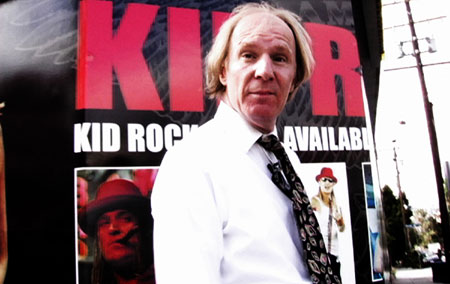
NEW YORK DOLLS NEVER DIE
...THANKS TO DVD
By Hollis James
Quietly charming, unassumingly majestic and disarmingly brilliant, the documentary New York Doll, based on the life
and times (and destruction and redemption and rock & roll resurgence) of Arthur "Killer" Kane--a man who (literally!) couldn't
breathe and play bass at the same time--is one of the best musician character studies of all time. This is not a film about a band
going out at the top of their game and on their own terms, ala Scorsese's The Last Waltz. Nor is this a film about some egomaniacal womanizing hack that played to the lowest common denominator--adding two chords and two chords together to make a million dollars. This is the story of a quiet man who lived in pain for decades, always trying to reconcile the unlimited potential of his youth with the bleak outlook of his future.
 A complex man with a big heart, Arthur was the soul of the New York Dolls. He managed to maintain a wide-eyed innocence about what lay
in store for his band and--right up until their red-patent-leather-clad death rattle while managed by a pre-Pistols Malcolm McClaren--he saw no limit to the Dolls future.
Ironically, it was this very admirable quality about Arthur that would ensure he'd fall further than his bandmates after the Dolls' sad break-up. This film documents Arthur's days playing with the coolest band on Earth--back when they seemed ready to take over
the world--through their subsequent failure to achieve mainstream acceptance, through Arthur's descent into alcoholism, past
his disillusionment with NYC and move to California, past his nearly successful suicide and following redemption through the
Mormon Church, and, finally, up to and including the New York Dolls' successful reunion concert at England's Meltdown Festival.
A complex man with a big heart, Arthur was the soul of the New York Dolls. He managed to maintain a wide-eyed innocence about what lay
in store for his band and--right up until their red-patent-leather-clad death rattle while managed by a pre-Pistols Malcolm McClaren--he saw no limit to the Dolls future.
Ironically, it was this very admirable quality about Arthur that would ensure he'd fall further than his bandmates after the Dolls' sad break-up. This film documents Arthur's days playing with the coolest band on Earth--back when they seemed ready to take over
the world--through their subsequent failure to achieve mainstream acceptance, through Arthur's descent into alcoholism, past
his disillusionment with NYC and move to California, past his nearly successful suicide and following redemption through the
Mormon Church, and, finally, up to and including the New York Dolls' successful reunion concert at England's Meltdown Festival.
In the topsy-turvy early days of the Dolls, it wasn't easy for any of the band members to keep a clear head, let alone make every gig. But--even during his battle with the bottle--Arthur was steady as a rock and dependable as they come. In fact, Arthur only missed a handful of gigs--and only then because Arthur's girlfriend at the time (a "pre-Dee Dee Ramone" Connie) tried to cut his thumb off to keep him from going on tour without her. Members died, members fought, members stormed off, but every gig Arthur was always stage right--holding his breath and playing his bass.
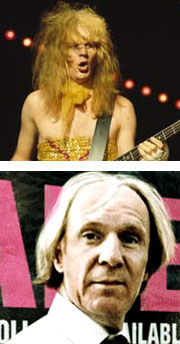 The New York Dolls were every girl's dream: men confident enough in their sexuality to play with high heels and make-up, but
unmistakably masculine. If a girl met a Doll after a gig and took him home, she could be sure of two things: he would fuck her
and he'd leave wearing her shirt. These young men were playing music as the most important part of their "music/drugs/liquor/women"
agenda. Whether the Dolls' members took part in all four at one time or dangerously focused on only one or two, these boys were
creating art using a scary paint box.
The New York Dolls were every girl's dream: men confident enough in their sexuality to play with high heels and make-up, but
unmistakably masculine. If a girl met a Doll after a gig and took him home, she could be sure of two things: he would fuck her
and he'd leave wearing her shirt. These young men were playing music as the most important part of their "music/drugs/liquor/women"
agenda. Whether the Dolls' members took part in all four at one time or dangerously focused on only one or two, these boys were
creating art using a scary paint box.
The most endearing part of this documentary is perhaps that its subject is (refreshingly) the most unlikely New York Doll to
have his story told--not to mention the most deserving of long-overdue celebrity status. Although he was unknown by the majority
of music fans, probably due to his being the least high-profile and (what's a worse sin in this country) least-attractive member
of the Dolls, we get the impression that Arthur Kane would have been fine with his low-profile status if only the Dolls had been
a success. He was content, and even seemed to prefer, staying in the background. If Arthur had slid back any further on stage each
night, he'd have knocked the amps over--and if he had slid any further in the corner, he'd have been playing in the wings. That
unassuming nature is a charming anomaly, a rare bastion of selflessness in a business rancid with ego. For Arthur, it was always
about the band. He was, in essence, the Dolls' biggest fan.
Arthur's tale is simple yet provides many unexpected twists and turns along the way. It's also one of the most uplifting true-life
narratives I've ever seen. It reminds us that one concert, one night, one moment can be victory enough. There are no punches pulled, and no schmaltzy Hollywood airbrushing to create a revisionist history.
This portrait is raw, painful, honestly rendered, truthful...and hence, beautiful. And I won't lie...I bawled my fucking eyes out.
This film has no car crashes, no explosions, no CGI, just real people, real emotions and reminders of our own frailty. You want
highlights? Okay, here are a few:
Arthur paid countless dollars to a local pawnshop for years to ensure that they wouldn't sell the bass he'd hocked. Yet over time, Arthur paid them enough to buy several bass guitars. It never occurred to this creature of habit, who lived so
long in quiet desperation, to simply save up for a new bass.
There are priceless interviews with his Mormon Church library coworkers--sweet people confronted for the first time with the
clash of the two worlds in which Arthur had equal citizenship. Although Arthur found salvation in their world, once the cameras
roll, it's charming to see these godly folks stiff-backed and nervous, as they tread water in Arthur's rock star world. Two of
his coworkers--old women straight out of a Norman Rockwell sketchbook--delightfully muse innocent on their ability to become groupies.
Since most groupies nowadays have blue hair anyway, why the hell not?
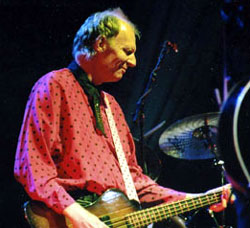 One big moment in the film is the band's first jam session for their Meltdown Festival reunion. Original Dolls Sylvain Sylvain
(the underrated engine that drove the Dolls train) and Arthur feel their way through a song with the younger musicians filling
out the ranks when David --Buster Poindexter-- Johansen (who is the closest thing this film has to a villain before he wins us over)
enters and begins singing into an inadequately juiced mic. The original Dolls can't seem to finish jamming soon enough in order to
get down to the more important business of hugging, reminiscing and forgetting. From there on, everything we want to happen does
happen. The Dolls are honored as conquering heroes at the festival banquet, the concert is a great success and all axes are buried
after years of contention and derision. Then Arthur dies.
One big moment in the film is the band's first jam session for their Meltdown Festival reunion. Original Dolls Sylvain Sylvain
(the underrated engine that drove the Dolls train) and Arthur feel their way through a song with the younger musicians filling
out the ranks when David --Buster Poindexter-- Johansen (who is the closest thing this film has to a villain before he wins us over)
enters and begins singing into an inadequately juiced mic. The original Dolls can't seem to finish jamming soon enough in order to
get down to the more important business of hugging, reminiscing and forgetting. From there on, everything we want to happen does
happen. The Dolls are honored as conquering heroes at the festival banquet, the concert is a great success and all axes are buried
after years of contention and derision. Then Arthur dies.
When Arthur passes away at 55, shortly after the Dolls' reunion concert, of leukemia that had long-gone undiagnosed, one can't help but feel--after
getting to know him onscreen for the bulk of the film--that he somehow fought off the disease just long enough to claim one final victory. A lesser man might not have even survived the Dolls' breakup and his ensuing alcoholism--let alone the 30 years of bad breaks that followed. But the kinder, gentler "Killer" Kane we get to know had eventually lost all trace of his edge, and at long last he was the one who was killed. Even at that saddest of moments the film manages to be touching without cloying, and keeps an unbiased foot deeply rooted in the real world. We're left, at the film's end, with the sight and sound of a downbeat Johansen crooning a spiritual in Arthur's memory. Whereas its subject's death might have been the
crescendo in a lesser film, here it's seen as the obvious end to a life whose biggest moments often occurred offstage. New York Doll is the story of a simple man who searched for--and finally found--peace in a complex world. At the end of the day, this film succeeds for the same reason the Dolls failed...it tells the truth.
NEW YORK DOLLS: ALL DOLLED UP

Films By Bob Gruen and Nadya Beck
There was once a photographer named Bob Gruen. He documented all things rock & roll. You ever see that picture of John Lennon wearing
shades and a New York City T-shirt? Yeah, Bob took that photo. He hung with the Hell's Angels, drank at Max's--he even once had
an afro worthy of battling the Dictators' Handsome Dick Manitoba for follicle supremacy of New York. Then one night Bob went down
to The Mercer Arts Center--a decrepit multi-room building that acted as the breeding ground for NYC's most experimental and cutting
edge music, theater and film--and he met the New York Dolls. Bob was so captivated by the band's charisma, raucous music and
photogenic nature that he and his wife, Nadya Beck, bought a portable video camera--in the days when only Bob Crane had one--and
took off on tour with them. Over the following three years, Bob and Nadya shot over 40 hours of the New York Dolls.
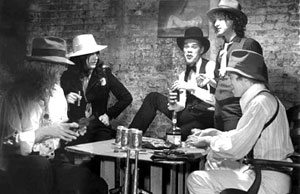 The footage that Bob and Nadya shot of the New York Dolls--from their early days building up major-label heat at local joints like
Kenny's Castaways (which was uptown then) to their final red-patent-leather concerts at the Little Hippodrome--is the only official
release stateside of any video capturing the Dolls not only in their prime but in front of appreciative audiences. This is rare
for many reasons. First off, obviously, no official release at all exists of the Dolls in their prime, outside of photographs and
enthusiastic book or magazine copy. Secondly, since they're now widely accepted as the important musical harbingers of a new sound and aesthetic that
every band (except the Dolls) would commercially capitalize on--such as safer bands like Aerosmith or Kiss, who weren't above winking at the audience to reassure them--what's often lost in the translation is how ahead of their time Dolls were. We've seen a million photos of the Dolls in their own element, at a Max's Kansas City or Mercer Arts Center, flanked by fans and friends dressed even weirder than they were. But now we get to see the reactions of "normal" people, the straight-world man on the street, as the gender-bending Dolls walk into an airport decked out in their high-heeled best. That moment alone acts as a reminder that no one outside of downtown New York, Los Angeles and rare pockets
in other big cities understood what the band was doing. The Dolls brought back the magic of the fifties and early sixties at a time when those years were un-cool. But the moments the Dolls were bringing back were the handpicked magical, frivolous daydreams that spoke to Elvis, girl groups, the three-minute single--and that momentary joy of successfully unhooking your girl's bra in a car just before she slaps your face. But mainstream audiences at the time were blinded by their arresting look. The rank and file has always needed a trail of breadcrumbs. Straight people don't connect Otis Redding with a blistering Dolls cover of his "Don't You Mess With Cupid." The common moron--uh, man needs the reassuring cartoonish trappings of Sha Na Na. The Dolls were doomed prophets because they brought the right musical message wrapped in too frightening a package.
The footage that Bob and Nadya shot of the New York Dolls--from their early days building up major-label heat at local joints like
Kenny's Castaways (which was uptown then) to their final red-patent-leather concerts at the Little Hippodrome--is the only official
release stateside of any video capturing the Dolls not only in their prime but in front of appreciative audiences. This is rare
for many reasons. First off, obviously, no official release at all exists of the Dolls in their prime, outside of photographs and
enthusiastic book or magazine copy. Secondly, since they're now widely accepted as the important musical harbingers of a new sound and aesthetic that
every band (except the Dolls) would commercially capitalize on--such as safer bands like Aerosmith or Kiss, who weren't above winking at the audience to reassure them--what's often lost in the translation is how ahead of their time Dolls were. We've seen a million photos of the Dolls in their own element, at a Max's Kansas City or Mercer Arts Center, flanked by fans and friends dressed even weirder than they were. But now we get to see the reactions of "normal" people, the straight-world man on the street, as the gender-bending Dolls walk into an airport decked out in their high-heeled best. That moment alone acts as a reminder that no one outside of downtown New York, Los Angeles and rare pockets
in other big cities understood what the band was doing. The Dolls brought back the magic of the fifties and early sixties at a time when those years were un-cool. But the moments the Dolls were bringing back were the handpicked magical, frivolous daydreams that spoke to Elvis, girl groups, the three-minute single--and that momentary joy of successfully unhooking your girl's bra in a car just before she slaps your face. But mainstream audiences at the time were blinded by their arresting look. The rank and file has always needed a trail of breadcrumbs. Straight people don't connect Otis Redding with a blistering Dolls cover of his "Don't You Mess With Cupid." The common moron--uh, man needs the reassuring cartoonish trappings of Sha Na Na. The Dolls were doomed prophets because they brought the right musical message wrapped in too frightening a package.
[Further proof of the multi-city fight the Dolls had on their hands every tour can be illustrated by the famous story of their Don Kirshner's Rock Concert appearance--tapes of which have been long traded and cherished by fans (like me), even given its poor quality, on the bootleg circuit. The Dolls apparently successful performance as far as the home-viewing audience was concerned, actually featured some TV trickery. Unbeknownst to the rest of the nation, the Dolls did not go over well with the in-house audience. Therefore the show's technical crew had to dub in the feverish audience applause and enthusiastic
screams that greeted the set of fellow Kirshner performers Rufus--who inexplicably played to a far more rapturous response. --HJ]
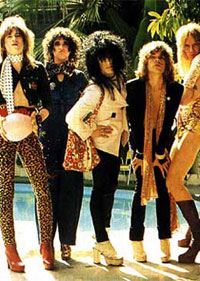 But that was then and this is now. Much like a nasty breakup with the right girl at the wrong time, the memories captured by
this DVD focus only on the potential, beauty and youth of the New York Dolls. What are forgotten in the nostalgic glow of your
TV are the Dolls' bad breaks, nasty run-ins, unsold records and drug-induced failures. Dolls fans have long had to be content with photos,
two albums, about a half-dozen bootlegs (repackaged over the years as thirty differently named bootlegs), and oral histories of
those lucky enough to have been there at the time. Now, we get it all: Johnny Thunders' family showing up at the airport to say
goodbye to him before his flight, backstage groupies (some eagerly snatched up, some humorously rebuffed), the Dolls backstage in between sets (sweaty
and worn out, yet charming as ever), the band posing for a photo session while The Kinks "Afternoon Tea" plays, the Dolls laying in the west coast grass on a day off, telling the history of the band. We
see the band playing their legendary gig in drag (all except for an uptight Johnny) at Club 82, the band playing at the
Matrix--with Peter Jordan on bass, during Arthur Kane's hand injury. Jordan plays surprisingly well as Arthur sways (inebriated?) next to Jerry Nolan's drum kit, mouthing along to the lyrics and looking ready to pass out.
But that was then and this is now. Much like a nasty breakup with the right girl at the wrong time, the memories captured by
this DVD focus only on the potential, beauty and youth of the New York Dolls. What are forgotten in the nostalgic glow of your
TV are the Dolls' bad breaks, nasty run-ins, unsold records and drug-induced failures. Dolls fans have long had to be content with photos,
two albums, about a half-dozen bootlegs (repackaged over the years as thirty differently named bootlegs), and oral histories of
those lucky enough to have been there at the time. Now, we get it all: Johnny Thunders' family showing up at the airport to say
goodbye to him before his flight, backstage groupies (some eagerly snatched up, some humorously rebuffed), the Dolls backstage in between sets (sweaty
and worn out, yet charming as ever), the band posing for a photo session while The Kinks "Afternoon Tea" plays, the Dolls laying in the west coast grass on a day off, telling the history of the band. We
see the band playing their legendary gig in drag (all except for an uptight Johnny) at Club 82, the band playing at the
Matrix--with Peter Jordan on bass, during Arthur Kane's hand injury. Jordan plays surprisingly well as Arthur sways (inebriated?) next to Jerry Nolan's drum kit, mouthing along to the lyrics and looking ready to pass out.
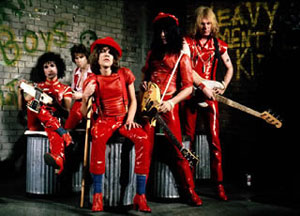 It's all here, unadulterated and, much like the New York Doll documentary, presented without any editorial slant. The
Dolls are laid bare, but unlike junkie-era Johnny Thunders bootleg concerts or Buster Poindexter-era SNL appearances, the real New York Dolls are finally represented. They're young again, and ready to defend themselves. All Dolled Up is a gift to the listening faithful, the true torchbearers of the Dolls' legacy. This is a band that fans have believed in mostly on faith, hearsay and the power of their sparse discography. But now, thanks to this release, the Dolls are finally allowed to put their best foot forward. Like them or not, the young, sexy and in-their-prime Dolls are back--wide open for their viewing audience to either instantly love them or
instantly hate them--the same as always.
It's all here, unadulterated and, much like the New York Doll documentary, presented without any editorial slant. The
Dolls are laid bare, but unlike junkie-era Johnny Thunders bootleg concerts or Buster Poindexter-era SNL appearances, the real New York Dolls are finally represented. They're young again, and ready to defend themselves. All Dolled Up is a gift to the listening faithful, the true torchbearers of the Dolls' legacy. This is a band that fans have believed in mostly on faith, hearsay and the power of their sparse discography. But now, thanks to this release, the Dolls are finally allowed to put their best foot forward. Like them or not, the young, sexy and in-their-prime Dolls are back--wide open for their viewing audience to either instantly love them or
instantly hate them--the same as always.
 |
|||||||||||||
 |
|||||||||||||
 | |||||||||||||
 | |||||||||||||
 | |||||||||||||
 | |||||||||||||
 | |||||||||||||
 | |||||||||||||
 | |||||||||||||
 | |||||||||||||
 | |||||||||||||
 | |||||||||||||
 | |||||||||||||
 | |||||||||||||
 | |||||||||||||
 | |||||||||||||
 | |||||||||||||
 | |||||||||||||
 | |||||||||||||
 | |||||||||||||
 | |||||||||||||
 | |||||||||||||
 | |||||||||||||
 | |||||||||||||
 | |||||||||||||
 | |||||||||||||
 | |||||||||||||
 | |||||||||||||